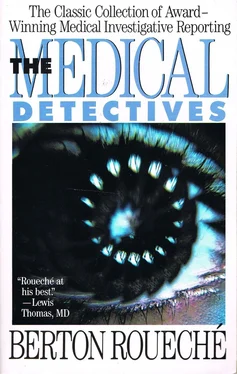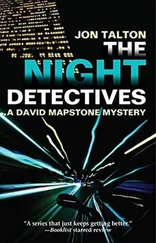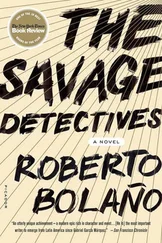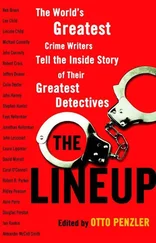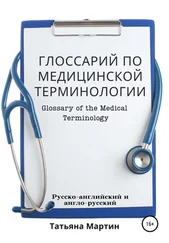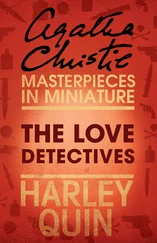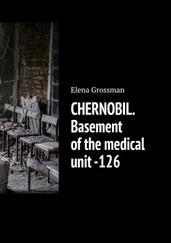"We were all more or less convinced that we were dealing with a food-borne agent centering on Luverne. What was needed now was a case-and-control study and a review of food sources. As it turned out, we did two such studies. Fifty confirmed cases were matched with fifty well individuals for age, sex, neighborhood, and so on. The first study narrowed the suspected food sources to commercially processed chicken and lean ground beef. The second eliminated the chicken and identified the ground beef as coming from the plant in Luverne that Larry Long had told me about. The store in Valley Springs and similar stores in Beaver Creek, Hills, and Luverne all sold that lean-cuisine beef. We had these findings by the end of July or early August. Our case total by then included two families in Sioux Falls. One of these was the Peskey family, and that presented no epidemiological problem. We knew where Mrs. Peskey got her ground lean beef. The other family could have been alarming—or, at least, confusing. Dan went to see them. He asked if they ate ground beef. They said yes. And where did they buy it? They said there was a little store over in Valley Springs that carried the best hamburger meat they'd ever had. It was so lean. We laid another worry to rest. At about the same time, we got an even more interesting report on a family living some little distance east of Luverne, outside the charted outbreak area. It was an extended family—three generations, numbering about fifteen people. All ages. There was no question about their illness. They were all confirmed cases of thyrotoxicosis—all but one, a boy of twelve. They got their ground beef from the plant in Luverne. One of the family worked there, and he brought the meat home. What about the boy? Oh, he was a vegetarian. Well, that was the 'My God—that's got to be it!'
"We had the vehicle, we were sure of it. There was no doubt in my mind or in the minds of Dan and Jan that the source of the outbreak was something in the extra-lean beef from the Luverne plant. Some of the others thought otherwise. Very well. But just what was that something? We didn't see how it could be a viral or bacterial contamination. The control studies showed us that practically all the cases liked their hamburgers well done. This isn't steak-tartare country. And, of course, cooking would have destroyed any microorganisms. That left the possibility of some chemical agent. But that couldn't be. I mean, there was no chemical agent known to us that could cause thyrotoxicosis. We came to a halt. The next move would be an investigation at the plant. The public-health officials in Minnesota were quietly making the necessary arrangements. That sort of thing is a delicate business. If the plant was deliberately doing something wrong, an impetuous move could alert it. But once the Luverne lean beef was clearly indicated I decided to take a look at the meat myself. I made another visit to the Clover Farm store in Valley Springs. Larry Long showed me into the walk-in cooler and pointed out the extra-lean beef. It was in chunks—dark-red meat. There was nothing visibly wrong with it. It's been a long time since I studied anatomy, but I could remember enough to recognize that what I was looking at was neck muscle. Well, the thyroid gland and the neck-strap muscle are very close neighbors. I had to think there was a good possibility that some of that meat was thyroid. In fact, there were traces of white tissue along the edges of some of the chunks. I bought a pound of that. Then, as I was leaving, I asked Larry Long something I probably should have asked long before. He and his wife were not on our list of cases, and he said they had never been sick. I asked him if he often ate that extra-lean beef. Often? He gave a little laugh. He said he and his wife owned the store. They didn't have to eat hamburger. They ate sirloin.
"I took my hamburger over to Jerry Simmons. Dr. Simmons is the pathologist at the medical school and the Laboratory of Clinical Medicine in Sioux Falls. I showed him my meat and told him what I had in mind. I pointed out those areas of white. Jerry gave me a look. He said, 'I could put this under the microscope, but it would be a waste of time. That white isn't thyroid. Thyroid gland is red—very dark red. That white is salivary gland.' I suggested we go back to Valley Springs together, and he would pick out some better samples. So we did, and he got some likely chunks, and we went back to the lab, and he prepared some samples for freezing. When the meat was frozen, he would slice off some razor-thin sections and stain them and put them under the microscope. He'd let me know the result. Which he did, about an hour later. He said, 'Mike, I think I can help you with your problem.' "
A Public-Health inspection of the Luverne plant was undertaken in the third week of August, under the general direction of Dr. Robert B. Janssen, from the Centers for Disease Control. A few days earlier, the plant had agreed to halt production of neck trim and to recall all known supplies from the stores. The findings of the investigating team were definitive. The plant was not a packinghouse. It was primarily a slaughterhouse. Dressed carcasses were shipped to another plant for processing. Only the heads were retained at Luverne. Neck muscle was trimmed from these heads and distributed to local retailers for sale as ninety-per-cent-lean beef. As was usual in the trade, every effort was made to recover as much trim as possible. The strap muscles were trimmed from their attachment to the trachea. It was apparent to the investigators that thyroid tissue was often inadvertently included in the beef trim. The plant produced an average of nine hundred pounds of trim each day. Certain changes had recently occurred at the plant. Until April of 1983, the plant had selectively removed the thyroid glands and sold the tissue to manufacturers of thyroid extract. That market vanished with the development of a synthetic thyroid extract. It was also learned that the plant had operated for many years as a kosher killing plant. That ended in November of 1984. Kosher killing made the thyroid gland readily recognizable. The neck meat remained red after the blood was drained off, but the thyroid turned pale. It was presumed that the end of this practice made it difficult for the trimmer to avoid including thyroid-gland tissue in the trim. Samples of trim were taken for extensive examination by three investigators in Massachusetts—Drs. Sidney Ingbar and Lewis Braverman (of "The Thyroid" fame) and Dr. Bruce Meyers. Their findings confirmed that the suspected beef trim produced and sold by the plant contained high concentrations of thyroid hormones. This confirmation was further confirmed by a test involving human volunteers. That test was performed, with the approval of the Human Subjects Institutional Review Committee, at the University of Massachusetts Medical School. Four volunteers ate samples of the implicated beef trim that had been ground and cooked into hamburgers. The samples had previously been cultured to exclude such disease organisms as salmonella; shigella, and Campylobacter. Blood samples for thyroid-related hormone analyses were obtained before and after eating. All the volunteers remained asymptomatic, but the serum tests showed the presence of thyroid hormone. The recall of the meat from the Minnesota and South Dakota stores brought an end to the outbreak. The known cases of thyrotoxicosis totaled a hundred and twenty-one, but it is probable that there were many cases in the affected area that were unknown to the investigators. There were no deaths, but a number of sufferers, mostly elderly people, were hospitalized. The investigation also led to the resolution of the uncertainties of the York County, Nebraska, outbreak of the year before. A significant majority of its victims were found to have eaten ground lean beef purchased from a single supermarket.
Читать дальше
